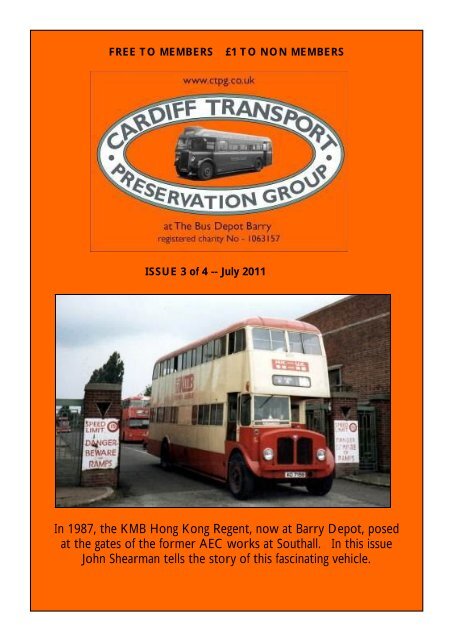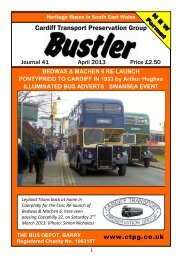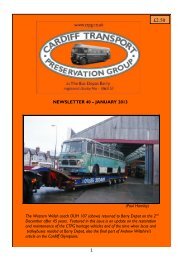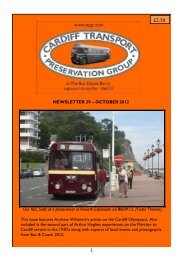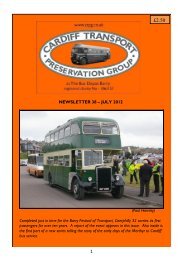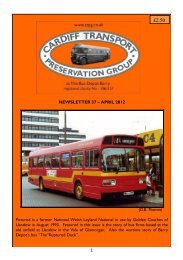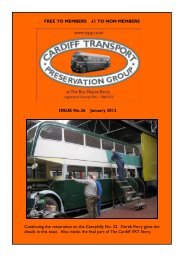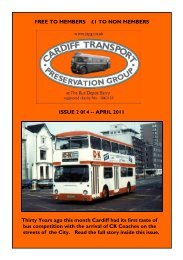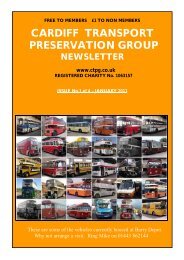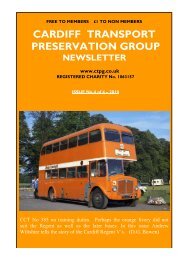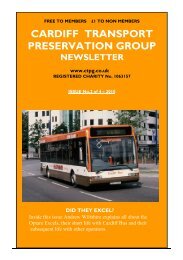Create successful ePaper yourself
Turn your PDF publications into a flip-book with our unique Google optimized e-Paper software.
FREE TO MEMBERS<br />
£1 TO NON MEMBERS<br />
ISSUE 3 <strong>of</strong> 4 -- July <strong>2011</strong><br />
In 1987, the KMB Hong Kong Regent, now at Barry Depot, posed<br />
at the gates <strong>of</strong> the former AEC works at Southall. In this issue<br />
John Shearman tells the story <strong>of</strong> this fascinating vehicle.<br />
1
These two Crosville RE’s visited Barry depot in May with the Merseyside Group. (P.Hamley)<br />
The temporary lake at the Hood Road Site during the Barry Festival <strong>of</strong> Transport held on<br />
12 th June <strong>2011</strong>. These four buses are currently housed at Barry Depot.<br />
2
CHAIRMAN’S MESSAGE;<br />
Who said it never rains at the Barry Rally! This year certainly proved them wrong<br />
because it certainly rained, the Saturday was perfect the buses were washed, fuelled<br />
and lined up ready for the Sunday we even had a BBQ and believed that the<br />
weathermen definitely had it wrong. However as Sunday dawned it was obvious they<br />
had it spot on, those buses that came including one from Exeter did not stay long as<br />
the showground became a large lake. We had to stay in the puddles though because<br />
the Depot was doing a roaring trade, everyone seemed to be inside either under the<br />
cover <strong>of</strong> the buses on road runs or under the Depot ro<strong>of</strong>. In the end we were only<br />
slightly down on previous years takings, which is due to those running the stall, selling<br />
programmes and the kitchen where the hot tea and c<strong>of</strong>fee seemed to be very<br />
welcome. Thank you to those members that made the effort to attend and assist on<br />
the day, there were some new faces but there were a lot <strong>of</strong> missing.<br />
Prior to the rally a number <strong>of</strong> buses were MOTed including 434, PAX, 143 and the<br />
R&W Tiger. The Swift lived upto the models reputation and failed to leave the Depot<br />
on rally day maybe it did not like the look <strong>of</strong> the weather.<br />
Work is progressing well on Caerphilly 32, most <strong>of</strong> the windows have been removed<br />
in preparation for it’s repaint, all the seat frames have been removed and repainted<br />
and the floor repaired. The upstairs ceiling panels have been prepared and the gloss is<br />
currently being applied.<br />
Our Aberdare UDC rare Guy LUF with Longwell Green body is now on the pit so<br />
that it can be surveyed for its future restoration, the initial prognosis is that it is not<br />
so bad. The main problem with the rotten floor being caused whilst the bus was<br />
stored on grass for many years prior to our ownership. The years <strong>of</strong> towing<br />
trolleybuses after sale from Aberdare do not seem to have resulted in any damage to<br />
the chassis.<br />
Merthyr Tydfil Council have confirmed sponsorship <strong>of</strong> Bus & Coach Wales which will<br />
take place on Sunday 4 th September, however this year the event moves to the<br />
Rhydycar Leisure Centre which is just <strong>of</strong>f the A470. The location contains the same<br />
sort <strong>of</strong> facilities as the college and we hope that the rally is as successful here as it was<br />
at the college. Please volunteer to help, we especially need assistance with<br />
marshalling.<br />
Keep upto date with Group News on Facebook and on the CTPG website<br />
Finally I would like to wish Viv a speedy recovery following his recent hospital stay.<br />
Mike<br />
Tel: 01443 753227<br />
email: mikeystrad73@btinternet.com<br />
3
DEPOT VISIT;<br />
Earlier this year Cardiff Transport Preservation Group were approached by the staff<br />
<strong>of</strong> Craig y Parc School, Pentyrch requesting a visit to our Broad Street Depot in<br />
Barry. The school caters for on average 56 pupils between the ages <strong>of</strong> 3 to 19 and is<br />
part residential and part day care, providing education and support for youngsters <strong>of</strong><br />
varying health backgrounds. Their aim is to achieve the full potential <strong>of</strong> these pupils<br />
and to give them a wider experience <strong>of</strong> local facilities, thus our much enjoyed visit<br />
from them on April 11 th .<br />
Mac. Winfield and myself<br />
welcomed seven young<br />
people together with their<br />
support team both male and<br />
female, which highlights that<br />
our facilities have a wide<br />
appeal. We were impressed<br />
by their two purpose built<br />
mini-buses which facilitated<br />
their wheel chairs so well, if<br />
only all public transport were<br />
able to accept these<br />
motorised chairs it would<br />
widen their horizons even<br />
further. One <strong>of</strong> the group,<br />
Ryan Escott, is also a member <strong>of</strong> the C.T.P.G. and was celebrating his 18 th birthday on<br />
this day, which made the visit even more special. Our visitors stayed for over an hour<br />
thoroughly enjoying themselves, collecting souvenirs on the way and taking<br />
refreshment before departing to the Ship Hotel, Barry for lunch. From a personal<br />
point <strong>of</strong> view it was a very successful visit and rewarding, seeing the delight in the<br />
faces <strong>of</strong> these young people. (Paul Gilbertson)<br />
APRIL MEETING;<br />
The meeting on 20 th April was well attended, to be entertained by Robert Edworthy<br />
who brought along some <strong>of</strong> his own collection <strong>of</strong> early cine film dating from the early<br />
1960s now transferred on to disc. The first half <strong>of</strong> the meeting was very varied,<br />
including footage <strong>of</strong> many now long gone bus companies such as Swindon, Midland<br />
Red, Maidstone & District and our own Red & White and Western Welsh. Also<br />
included was a detailed viewing taken by Robert <strong>of</strong> the construction <strong>of</strong> the first<br />
Severn Bridge (1966) and included rare shots <strong>of</strong> the Severn Estuary ferries which plied<br />
there trade between Beachley and Aust. The second half <strong>of</strong> the evening was a review<br />
<strong>of</strong> last years Showbus event at Duxford where we were shown a very varied selection<br />
<strong>of</strong> some <strong>of</strong> the 500 buses/coaches which participated, including some from the 1930s.<br />
(Paul Gilbertson)<br />
4
MAYROAD RUN;<br />
On 18 th May we held<br />
our first road run <strong>of</strong><br />
the year. With the<br />
co-operation <strong>of</strong> Mal<br />
Hier and the SWT<br />
Preservation Trust,<br />
almost 40 members<br />
and guests visited<br />
the Swansea Bus<br />
Museum. Our<br />
transport was their<br />
fine ex. Morris Bros.<br />
Volvo coach FTH 991V,<br />
Setting <strong>of</strong>f from County Hall (V.C.)<br />
now restored to its<br />
original 1981 British Coachways livery. This was much faster than our usual mode <strong>of</strong><br />
transport. An excellent evening!<br />
5<br />
JUNE ROAD RUN;<br />
On Wednesday the<br />
15th <strong>of</strong> June some 34<br />
members, family and<br />
friends assembled at the<br />
Broad Street Depot for<br />
an evening outing in<br />
Peter Taylor’s<br />
magnificently restored<br />
Routemaster RM244.<br />
This was previously<br />
registered as XVS839<br />
and following a change<br />
Red Bus at the Red Lion (Paul Hamley)<br />
<strong>of</strong> ownership now sports<br />
VLT250. Departing<br />
promptly at 19.00, we passed the Cardiff (Wales) Airport, through Rhoose & St.<br />
Athan, the largest military airfield in Wales, before joining the route to Cowbridge via<br />
Llandow. This was once the scene <strong>of</strong> the largest loss <strong>of</strong> life <strong>of</strong> a British civil aircraft on<br />
the 12 th March 1950 involving 80 persons returning to Wales following the rugby<br />
match against Ireland in Dublin. The site is marked by a roadside memorial. A too<br />
brief stop was made for refreshment at the Red Lion in St. Nicholas before returning<br />
to Barry in what was probably a first visit to the Vale by a Routemaster. (P.G.)
THE DAY THAT THE RAINS CAME DOWN;<br />
On the 12 th June, the day <strong>of</strong> the <strong>2011</strong> Barry Festival <strong>of</strong> Transport, the heavens opened<br />
with nearly 24 hours <strong>of</strong> incessant heavy rain. The hard standing at the Hood Road<br />
site where the 30 or so buses would have parked was flooded to about 9 inches and<br />
the grass car arena was also sodden. It was not surprising that only a small fraction <strong>of</strong><br />
the over 200 vehicles entered actually turned up and many <strong>of</strong> these hardy individuals<br />
left after an hour or so. This was a pity as this year we had excellent press coverage<br />
for this event, thanks to Tudor Thomas, our new Publicity Officer.<br />
The heavy deluge was not unique to south Wales as those who watched the<br />
waterlogged FI Canadian Grand Prix later in the day will verify. At least our buses did<br />
not have to start from the depot following a safety car!<br />
About ten <strong>of</strong> the depot based buses were on the road, many <strong>of</strong> which took turns in<br />
providing free trips for the public to Barry Island and to the Rhoose Flying Club (a<br />
new venue for this year). The Cardiff Swift again proved problematical, starting up,<br />
but then refusing to leave the depot. After years in dry storage her big round eyes<br />
took one look at the rain and decided to stay in the dry! Pontypridd No. 8 and the<br />
MW coach were awaiting MOT’s, so they were placed on the depot patch along with<br />
the Bustler minibus.<br />
The newly re-titled Barry Tourist Railway provided a class 73 with 3 coaches running<br />
between the Rally Site and Barry Island Station, but sadly they carried little traffic.<br />
However, the day was not all doom and gloom as record crowds visited the depot<br />
where the stalls and canteen were quite busy. A regular visitor again this year was the<br />
Vale Assembly Minister, Jane Hutt and her husband. Councillor John Clifford, the<br />
new Vale <strong>of</strong> Glamorgan Mayor and his Consort Carol Williams, paid their first visit to<br />
the event and were impressed with the progress the CTPG had made in restoring<br />
both the depot building and the historic buses. The Mayor had also been a bus driver<br />
many years ago and was fascinated by the amount <strong>of</strong> memorabilia on show in the<br />
Brinkworth Heritage Room. Our regular enthusiast visitors also spent more <strong>of</strong> their<br />
time looking over our collection<br />
It was thanks to our Chairman, Mike Taylor, and the hardy band <strong>of</strong> (very wet)<br />
volunteers that the event actually took place at all. Thanks too, to the volunteer<br />
drivers who trundled around in the rain for the benefit <strong>of</strong> our visitors. Your scribe<br />
was one <strong>of</strong> the fortunate helpers that kept dry, manning the group stall inside the<br />
depot.<br />
We now look forward to the Bus & Coach Wales event on 4 th September. Surely it<br />
can’t rain again, can it?<br />
6
7
KOWLOON MOTOR BUS Co. (1933) Ltd. (Hong Kong)<br />
Fleet number<br />
Chassis type:<br />
Engine<br />
Wheelbase:<br />
Body :<br />
A165<br />
AEC (Southall) Regent V, 2D2RA-1769<br />
(semi-automatic, electro-pneumatic control)<br />
AEC AV690 (11.3 litres) (wet liners)<br />
21feet 6inches<br />
Metal Sections Ltd. (‘MetSec’) (Oldbury)<br />
Supplied CKD (Completely-Knocked-Down) (i.e. in kit form)<br />
Assembled by Kowloon Motor Bus<br />
H50/28F&R+39 (78seats + 39standees = total 117) (as built)<br />
H51/39F&C+24 (90seats + 24standees = total 114) (as rebuilt)<br />
34feet 3inches long (plus front bumper)<br />
Entered service April 1966<br />
Substantially rebuilt for one-man-operation March 1982<br />
Withdrawn from service March 1987<br />
Exported to / imported into UK for preservation June / July<br />
1987<br />
Hong Kong registration number AD 7156<br />
UK registration number ABW 225D (age related no. for 1966)<br />
INTRODUCTION:<br />
In the sub-zero freezing conditions <strong>of</strong> Wednesday 8 th December 2010, ‘The Bus<br />
Depot, Barry’ saw the arrival <strong>of</strong> what some may regard as the ultimate development<br />
<strong>of</strong> the traditional front-engine, half-cab, two-axle, double-decker bus, in that the new<br />
addition is a representative <strong>of</strong> the largest and longest <strong>of</strong> such buses ever built.<br />
Traditional buses <strong>of</strong> such high capacity and length were never allowed in Britain.<br />
Although latterly rebuilt with centre doorway and centre staircase, this bus’s<br />
bodywork was also <strong>of</strong> traditional design as it was originally built with a rear platform<br />
and a rear staircase. The bus has a curious interest as it combines an overall design<br />
concept that is blatantly the traditional double-decker as once seen throughout the<br />
British Isles, and yet it also incorporates many features which are demonstrably for an<br />
utterly different bus operating environment.<br />
BACKGROUND:<br />
By the early 1960s the British Crown Colony <strong>of</strong> Hong Kong was being inundated by a<br />
massive flow <strong>of</strong> refugees crossing into the territory from China. Vast new<br />
resettlement estates were being built to house these people, many on hilly terrain,<br />
and the bus companies were finding it ever more demanding and challenging to serve<br />
these new areas <strong>of</strong> housing and associated new industrial areas.<br />
The Kowloon Motor Bus Company (KMB) which had the bus operating monopoly on<br />
the intensely urbanised Kowloon peninsula <strong>of</strong> Hong Kong had been loyal to Daimler<br />
for the supply <strong>of</strong> its double-deckers since its first such buses had been introduced in<br />
8
1949. Thus it requested Daimler to produce a CVG (Commercial Vehicle Gardner)<br />
series chassis longer than its prevailing 30-feet maximum length double-decker bus<br />
chassis. In the event Daimler were either unable or unwilling to do this, and so AEC<br />
seized the opportunity <strong>of</strong> breaking into the large and ever-expanding, and lucrative,<br />
Hong Kong bus market by <strong>of</strong>fering to satisfy KMB’s requirement for an urban bus<br />
which, at that time, would be <strong>of</strong> virtually unheard <strong>of</strong> size for a two axle vehicle.<br />
AEC was able to take immediate advantage <strong>of</strong> their head start in the design and<br />
manufacture <strong>of</strong> 34 feet long bus chassis frames on 2-axles as Regal III single-deckers <strong>of</strong><br />
that length had already been supplied to Uganda, and same length Regal V singledeckers<br />
to other export markets. That product design could readily be adapted to<br />
become Regent V double-deckers, specifically for KMB.<br />
A165 in service at Star Ferry en route to Lai Chi Kok in Nov. 1973 (B.J.Rusk)<br />
Thus it was that KMB ordered 70 ‘big’ AECs. It is believed that some or all <strong>of</strong> the<br />
chassis were delivered in Completely-Knocked-Down (CKD) form for local assembly<br />
by KMB. Their bodies were also supplied in kit form from the UK, the first 30 being a<br />
British Aluminium Company (BACO) product, the other 40 being produced by Metal<br />
Sections Ltd. (MetSec). BACO bodies were aluminium framed; MetSec bodies steel<br />
framed. They were KMB classes AEC(a)/30 and AEC(a)/40 respectively, entering<br />
service through 1963 and 1964.<br />
The successful performance <strong>of</strong> these 70 huge buses soon resulted in another 40 AECs<br />
being ordered and these entered service in 1965 as KMB class AEC(b). That was<br />
promptly followed by a third order which called for another 100 such buses and<br />
9
which entered service in 1965 and 1966 as KMB class AEC(c). All 140 buses <strong>of</strong> the<br />
second and third orders had MetSec bodies, i.e. with steel frames. All 210 bodies<br />
were similar, but not identical, with their large rear platform and rear staircase, and<br />
with a front doorway but no front staircase. Initially the first 70 had both the rear<br />
platform and the front doorway protected by linked sliding gates, manually worked by<br />
a gateman. There were two roving conductors, one for each deck. With the driver,<br />
that gave a total crew compliment <strong>of</strong> up to four! However, at some stage, the<br />
gateman’s job was taken-over by the lower deck roving conductor.<br />
That labour intensive system was replaced by one-conductor-operation (known by<br />
KMB as OCO), thus reducing the crew to two. This was achieved by replacing the<br />
gates and gateman by power-operated folding doors worked by the conductor, now<br />
seated at a fare desk. A one-way passenger-flow system, passing the desk, was<br />
introduced. Unlike the 70 AEC(a) class, the 140 AEC(b) and AEC(c) classes entered<br />
service in this revised body layout as OCO buses.<br />
In 1975 and 1978 two <strong>of</strong> the ‘big’ AECs had their bodies substantially rebuilt to<br />
render them suitable for one-man-operation (OMO). A flat-fare with fare-box, with<br />
neither change given nor ticket issued, was adopted in conjunction with a passengerflow<br />
system. This involved the removal <strong>of</strong> the rear platform and the rear staircase,<br />
for which were substituted a wide centre exit and a centre staircase. The front<br />
entrance was repositioned and narrowed. This body design layout and operating<br />
method proved extremely successful and so, even though it was now late in their<br />
lives, during the period 1980 <strong>–</strong> 1982, the other 208 AECs were all rebuilt in the same<br />
way as the two. In this form all 210 AECs were reclassified as KMB class AEC(CS),<br />
CS indicating centre staircase.<br />
Metal Sections Ltd., or MetSec, whose bodies were on 180 <strong>of</strong> the 210 AECs, are<br />
names not widely known in bus preservation circles and yet, despite that widespread<br />
oversight, the Company was one <strong>of</strong> the UK’s most prolific and important contributors<br />
to the British bus body building industry. The low pr<strong>of</strong>ile <strong>of</strong> the MetSec name is<br />
explained because Metal Sections Ltd. did not produce completed bus bodies. Instead<br />
it was a major supplier <strong>of</strong> prefabricated bus body framework parts to several <strong>of</strong> the<br />
body builders whose names are entirely familiar. It was also a very large scale<br />
exporter <strong>of</strong> bus body framework kits, crated for shipment overseas for local<br />
assembly. Hence the Company’s marketing slogan “a bus in a box”. It is therefore<br />
important that at least one example <strong>of</strong> an exported MetSec body is now preserved<br />
back here in the UK to represent the vast number <strong>of</strong> bus bodies produced by this<br />
major, but somewhat obscure, manufacturer.<br />
Daimler, realising that they had lost the market, did then belatedly <strong>of</strong>fer a 34-feet long<br />
version <strong>of</strong> their CVG6* model. KMB then reverted to ordering Gardner engined<br />
Daimlers, not necessarily because <strong>of</strong> any inherent problem with the AECs but mostly<br />
because Gardner was the much preferred and standard engine throughout Hong<br />
10
Kong. (* Worldwide, only KMB received 34-feet long AEC Regent V and Daimler<br />
CVG6-34 double-deckers.)<br />
Despite their non-standard engines (that is non-standard only in terms <strong>of</strong> Hong Kong<br />
engine speak!), KMB’s AEC AV690 engined Regent Vs <strong>of</strong> 1963 <strong>–</strong> 1966 had a typical life<br />
span <strong>of</strong> 21 years. All were withdrawn from service over the years 1983 <strong>–</strong> 1987. For<br />
most <strong>of</strong> their long lives they were working extremely hard on very busy front line<br />
routes in a tough operating environment ranging from twenty hour days, seven days a<br />
week to severe and frequent overloading (during a period <strong>of</strong> political strife in the late<br />
1960s these AECs <strong>of</strong>ten carried way in excess <strong>of</strong> 200 passengers!), some steep<br />
gradients to tackle, and in a hot and humid climate. They were indeed most<br />
successful buses, impressively massive; traditionally British whilst also being to<br />
extreme export specifications !<br />
A165 posed outside the closed AEC factory at Southall. July 1987 (J. Shearman)<br />
However, out <strong>of</strong> necessity because <strong>of</strong> the increasing unavailability <strong>of</strong> AEC spare parts,<br />
latterly a very small number <strong>of</strong> the AECs were partially “Daimlerised” by the<br />
installation <strong>of</strong> certain Daimler components including back axles, and likewise a handful<br />
were fitted with Gardner 6LX engines.<br />
Until 1974 KMB’s buses were identified by their registration numbers. KMB did not<br />
fleet number their buses until that year when the 210 AECs became A1 <strong>–</strong> A210, in<br />
their strict registration number sequence.<br />
SPECIFICALLY, A165:<br />
This particular bus was a member <strong>of</strong> the final batch <strong>of</strong> KMB’s ‘big’ AECs which<br />
comprised 100 vehicles, i.e. it was one <strong>of</strong> the MetSec bodied KMB class AEC(c) buses.<br />
11
However, as explained above, like every other <strong>of</strong> the 210 AECs it was latterly rebuilt<br />
to become reclassified as a KMB class AEC(CS) bus, and in that form it remains.<br />
The bus was first registered on 18 th April 1966 as AD 7156 but was not fleet<br />
numbered until 1974, becoming A165. It was a late survivor <strong>of</strong> the AECs in service,<br />
not being withdrawn until 19 th March 1987. By that time it had been demoted to<br />
secondary routes serving Hong Kong’s New Territories. (The final handful <strong>of</strong> KMB’s<br />
AECs lingered on until the August.)<br />
The letter “L” on the front dash beneath the driver’s windscreen is the depot<br />
allocation code for KMB’s Lai Chi Kok multi-storey depot.<br />
Upon withdrawal on 19 th March 1987 it was immediately purchased by its present<br />
owner (the writer <strong>of</strong> this account, John Shearman) for preservation in the UK. It was<br />
shipped on 13 th June 1987, arriving at Tilbury Docks on 11 th July after having been<br />
through the Suez Canal and being transhipped at Rotterdam. On 18 th July it was<br />
driven under its own power from Tilbury, through central London, posing at the<br />
gateway to the by then erstwhile AEC factory at Southall, to the Oxford Bus Museum<br />
at Long Hanborough where it was variously stored in the open and properly displayed<br />
within the Museum building for some two decades.<br />
Pictured at the Barry Festival <strong>of</strong> Transport on 12 th June <strong>2011</strong> (V.C.)<br />
By 2004 the bus required repainting and some minor bodywork attention and so it<br />
was sent to Thamesdown Transport (TT) in Swindon on 23 rd November 2004. There<br />
it languished for more than three years as TT found itself overburdened with work.<br />
Nonetheless it left Swindon for its return to Long Hanborough on 20 th February 2008<br />
12
with, amongst some other rectification work done, a complete repaint, both internal<br />
and external, and with its first ever UK MOT certificate as it had not been used on<br />
the road at Oxford. On 22 nd May 2008 the bus was first registered in the UK being<br />
allocated a local Oxfordshire registration number, ABW 225D, accurately age-related<br />
to the year it first entered service, 1966.<br />
Then, occasionally, during the three summers <strong>of</strong> 2008 <strong>–</strong> 2010, the Hong Kong bus<br />
served the Oxford Bus Museum by working on its free bus services.<br />
That Museum remained as A165’s home until 8 th December 2010 on which day its<br />
seemingly ever westwards migration resumed, again driven under its own power, this<br />
leg being Long Hanborough to Barry.<br />
For those who wonder at the unfamiliar radiator grille, the answer is that all 210 <strong>of</strong><br />
the AECs did start life with standard AEC Regent V grilles. Gradually, as these<br />
suffered damage, over the years they were replaced by the simple KMB produced<br />
grilles <strong>of</strong> the style (there were variations) that A165 now carries. Rather unattractive,<br />
though at least its present grille further adds to the bus looking ‘different’ !<br />
Finally, the hard fibre-glass seats are by no means as uncomfortable as they look. In<br />
the hot and humid, seasonally wet, climate <strong>of</strong> Hong Kong they were easily washed,<br />
dried and kept clean and, most importantly, did not harbour vermin.<br />
COMMENTS :<br />
This vehicle is one <strong>of</strong> the very few preserved examples in the UK <strong>of</strong> a bus designed<br />
and built specifically to meet the requirements <strong>of</strong> a particular export market, and as<br />
such it is now all the more <strong>of</strong> a rarity here with not only its chassis but also its body<br />
being <strong>of</strong> British manufacture. The substantial majority <strong>of</strong> British bus exports were <strong>of</strong><br />
chassis destined to receive bodies built elsewhere, although numerous British bus<br />
bodies were also exported.<br />
Perhaps it is also worth noting that the AEC bus from Hong Kong has importance on<br />
the bus preservation scene because, otherwise, an entire dimension in the history <strong>of</strong><br />
the British bus manufacturing industry has inevitably had to be neglected, if not<br />
entirely ignored. The British bus export business, for decades to all continents, is a<br />
bare shadow <strong>of</strong> its past performance but it was once on a massive scale, even rivalling<br />
the number <strong>of</strong> buses being sold domestically. Indeed, the pro<strong>of</strong> <strong>of</strong> the importance <strong>of</strong><br />
the earlier but now lost export markets is reflected by the situation on the streets <strong>of</strong><br />
today’s Britain. As a direct consequence <strong>of</strong> the steady loss <strong>of</strong> the bus export markets<br />
on which the overall production viability <strong>of</strong> all British built buses depended, not only<br />
did the entire British bus manufacturing industry decline to its present relative<br />
obscurity in global percentage terms, but so too now has much <strong>of</strong> the UK home<br />
market also been lost to imports.<br />
For further reading see also : “BUSES EXTRA”, 50 th issue. ”HONG KONG BUSES<br />
Volume 2, KOWLOON MOTOR BUS Co. (1933) Ltd, from 1933” by Mike Davis.<br />
13
OOPS 7;<br />
Another unintentional open-topper! Western Welsh Atlantean 308 came to grief while<br />
working from Cwmbran depot in August 1967. For the second time in just over a year<br />
Cwmbran lost a double deck in this fashion. Perhaps a momentary lapse <strong>of</strong> concentration,<br />
but TUH 308 took much longer to repair. It returned to Cwmbran in April 1968, no doubt<br />
with a “This is a double deck” sticker in the cab.<br />
--------------------------------------------------------------<br />
Maybe I shouldn’t<br />
have said “Send<br />
the fine to head<br />
<strong>of</strong>fice”<br />
14
THE CCT AEC MATADOR DKG601 by Anthony Brewer<br />
DKG601 holds the distinction <strong>of</strong> being the longest serving vehicle ever to operate in<br />
the Cardiff Corporation Transport fleet. Purchased in 1948 to assist in delivery <strong>of</strong><br />
new trolleybuses, the AEC Matador served as a recovery vehicle throughout four<br />
consecutive decades until its final withdrawal from service in 1986. It was the last<br />
AEC vehicle used by CCT, having outlasted the final AEC Regent V double-deckers<br />
(410-411DBO) that were sold for scrap in 1980 and the last AEC Swift single-decker<br />
(Ex Driver Trainer MBO508F) donated to Rumney Technical College in 1980. Now<br />
66 years old, the remains <strong>of</strong> this once fine vehicle still lie abandoned in woodland in<br />
the Forest <strong>of</strong> Dean.<br />
Military History<br />
At Pengam in 1949 with Trolleybus 264. (M. Winfield)<br />
DKG601 had a life in the British Army prior to purchase by Cardiff Corporation<br />
Transport. It was new in May 1944 as chassis number 08537618, fitted with an AEC<br />
A187 7.7 litre diesel engine and air pressure braking system from new, as part <strong>of</strong> a<br />
Second World War Army contract number 52263 which consisted <strong>of</strong> an order for<br />
500 “Medium Artillery Tractors” carrying Army fleet-numbers <strong>of</strong> H5470703 to<br />
H5471202. New, as fleet-number H5470718, it had wooden lower body panels,<br />
covered by a removable canvas top - this being the most common body construction<br />
on Army Matadors at this time. The job <strong>of</strong> the vehicle was to carry personnel and<br />
15
ammunition within the vehicle body itself, whilst towing the associated gun and gun<br />
carrier. Over 10,000 similar AEC Matadors were built between 1938 and the early<br />
1950s.<br />
CCT History<br />
Cardiff Corporation purchased the AEC Matador on May 13 1948 at a cost <strong>of</strong> £1005<br />
4s 8d, subsequently registering the vehicle as DKG601. The body was initially used<br />
in flatbed form with a straight bar tow, but an under-body winch was available for<br />
use in recovery operations. After a period in grey livery it was repainted in the<br />
standard Crimson Lake fleet colours applied at that time. The main duty for the<br />
Matador between 1948 and 1955 involved the collection <strong>of</strong> newly built BUT (British<br />
United Traction) trolleybuses from East Lancashire Coachbuilders Ltd. Blackburn<br />
(and possibly from the associated Yorkshire Equipment Company) as well as Bruce<br />
Coachworks at Pengam Moors, Cardiff.<br />
In 1956 a coach built body was constructed at Roath Depot bodyshop which<br />
included a front ro<strong>of</strong> dome <strong>of</strong> the type previously fitted to the Daimler CVD6s 52-61<br />
before their re-bodying by Longwell Green. The bodywork and machinery associated<br />
with DKG601 was completely revised at this stage to incorporate a body mounted<br />
Harvey Frost twin boom recovery crane. During the financial year ended 31/03/1967<br />
the Matador and two Land-Rovers were equipped with the first two-way radio<br />
telephones to be used by CCT and it was around this time that an illuminated towing<br />
sign was fitted centrally to the ro<strong>of</strong> dome just above the cab windows and later a<br />
flashing amber beacon was mounted on the ro<strong>of</strong>. Also around this time, CCT<br />
arranged with Michelin for the replacement <strong>of</strong> the MoD style balloon tyres by<br />
standard 10.00 x 20 tyres. In the mid 1970s, the Matador was repainted in the bright<br />
yellow used on council highways vehicles and numbered 061 in the service vehicle<br />
fleet. From around the mid 1950s the Matador was operated on trade plates 048<br />
BO with these being positioned back and front covering the DKG 601 registration<br />
mark.<br />
Life at Stevensons, Uttoxeter<br />
Sold by CCT in July 1986, just prior to deregulation <strong>of</strong> the bus industry, DKG601<br />
was purchased by Jeff Lister (Dealer) <strong>of</strong> Bolton as part <strong>of</strong> a tender which included the<br />
sale <strong>of</strong> Leyland National 201/202, Bristol VRT/ECW 600 and the last Cardiff Daimler<br />
Fleetlines 485/568/570.<br />
The following month saw DKG601 join the fleet <strong>of</strong> Stevensons <strong>of</strong> Uttoxeter in<br />
Staffordshire as a recovery vehicle, as a stopgap measure. Based at Uttoxeter depot,<br />
the AEC would generally be parked in the same yard as PAX466F (The ex Bedwas &<br />
Machen PD3 now based at Barry). Jeff Lister also sold engineless ex CCT VRT/ECW<br />
PKG600M to Stevensons as a source <strong>of</strong> spares. By 1987 DKG601 was surplus to<br />
16
equirements at Stevensons, and the decision was made to donate the Matador to<br />
the BaMMOT bus museum at Wythall.<br />
At Stevenson’s Yard in 1986 (A. Brewer)<br />
BaMMOT, Wythall<br />
Now in preservation, DKG601 received a new age related registration number<br />
HSU848 (I am not sure what happened to the original identity) and continued in use<br />
as a recovery vehicle with BaMMOT. During its time at the museum the largest<br />
vehicle towed was the twin staircase former Walsall 36 feet long Daimler Fleetline.<br />
XDH56G was an 86 seat front entrance/rear exit Fleetline with Cummins power unit<br />
that was unique in the UK. After towing preserved buses for many years, BaMMOT<br />
decided to replace the Matador with a newer commercial vehicle with more up to<br />
date safety features. As the replacement was not built as a recovery vehicle, it was<br />
decided to remove the body mounted crane from DKG601 and fit it to the new<br />
vehicle. The AEC engine and gearbox were removed with a view to re-fitting them in<br />
an ex Trent S.O.S. chassis under restoration at the time.<br />
Luther, Forest <strong>of</strong> Dean<br />
The remains <strong>of</strong> the vehicle were sold to AEC enthusiast Luther <strong>of</strong> Gorsley (near<br />
Newent) in the Forest <strong>of</strong> Dean in 1996, to provide spare parts for other Matador<br />
restoration projects. In the event very little had been taken from the vehicle and the<br />
17
ody <strong>of</strong> DKG601 still lay in woodland in Gorsley in 2010. Around 2005, DKG601<br />
survived a severe fire, which ripped through the associated wood yard. The body<br />
only had its paintwork scorched, but the severe heat did manage to melt the rear<br />
tyres. Despite what DKG601 has been through, the fact is that it still exists, and<br />
remains restorable. Although it would take a lot <strong>of</strong> hard work and dedication, the<br />
Matador could most easily be restored to its 1948 CCT operating condition. This<br />
AEC deserves to be saved not only in respect <strong>of</strong> its long CCT service record, but<br />
also because it served equally to both motorbus and trolleybus fleets within its<br />
lifetime in Cardiff.<br />
Some “Matador Memories”<br />
“Matador to the Rescue <strong>–</strong> all in good time!” by Gordon Mills<br />
(Former CCT Technical Engineer who moved to Grampian in 1986)<br />
I have an abiding memory <strong>of</strong> being “sand-bagged” into doing a job with the Matador<br />
around about early 1974. The Leyland Nationals were new and as I recall, prior to<br />
this the Swifts were always used for private hire jobs as they had a good turn <strong>of</strong><br />
speed. This capability <strong>of</strong>ten lead to them limping home with a cylinder head gasket<br />
gone. A private hire order for a trip to London one Sunday came up and someone<br />
decided to send a brand new Leyland National, after all they had no cylinder head<br />
gasket, being fitted with the “fixed head 500” engine. Nice idea, but the bus<br />
concerned (one <strong>of</strong> the 202-211 batch, I can’t remember which) had only been<br />
delivered a week earlier and on the return journey on Sunday evening was pulled into<br />
Membury Services on the M4 with alarms ringing and the “low coolant” light flashing.<br />
Reports were made <strong>of</strong> attempts to top up with water resulting in large amounts <strong>of</strong><br />
water pouring out <strong>of</strong> the engine and not being able to restart it. Suffice to say, a Swift<br />
was despatched to rescue the passengers and the stricken National was abandoned at<br />
Membury for the night.<br />
A young Technical Engineer arrived in his <strong>of</strong>fice at Roath on Monday morning to be<br />
greeted by a phone call from the engineering <strong>of</strong>fice at Sloper Road, “We’re shorthanded<br />
here and you know all about these new buses, will you go out to Membury<br />
with the Chargehand and rescue a new National?”. Always up for a challenge, I said<br />
“OK”. I told the Assistant Engineer what I was up to and agreeing this would be a<br />
good experience he said “go ahead, I’ll see you tomorrow”. I made my way to Sloper<br />
Road and noted the Chargehand had mustered the Matador and was putting his<br />
toolbox and a selection <strong>of</strong> spares, cans <strong>of</strong> coolant etc. on board. I had equipped<br />
myself with an all types PSV driving licence whilst at Newport Borough Transport and<br />
it was at that time permissible to drive an HGV with a PSV licence in order to attend<br />
a breakdown <strong>of</strong> a PSV. I had driven the Newport Matador around the yard, so was<br />
looking forward to having a serious drive <strong>of</strong> the Cardiff machine, possibly with a bus<br />
on the end <strong>of</strong> the twin boom crane behind. I should mention that I was wearing my<br />
18
suit and tie, then standard fare for aspiring young managers, and apart from a raincoat<br />
had no further protection from grease and oil. (I never did seem to learn!)<br />
At Sloper Road Depot (Mac Winfield)<br />
Having been fully briefed by the engineering staff I walked out to find the Chargehand<br />
sitting in the passenger seat. Good, I get first shot behind the wheel I thought and<br />
carried on. The Matador has the standard 7.7 litre diesel engine coupled to a four<br />
speed crash gearbox, I quickly found my feet and after just a few “crunches” settled<br />
down to a steady pace through the town and Eastwards to the city boundary. After a<br />
while I ventured to ask the Chargehand when would he like to take over the driving,<br />
suggesting a cup <strong>of</strong> tea at Aust services on the far end <strong>of</strong> the Severn Bridge. To my<br />
dismay, he disclosed that he was afraid he held neither an HGV nor a PSV driving<br />
licence and I would be doing all the driving, but the cup <strong>of</strong> tea was a nice idea! It was<br />
the normal thing then for garage staff to road test buses with a car licence and only a<br />
few had been tested to PSV or HGV standard for recovery work. I had made the<br />
presumption that my companion was one <strong>of</strong> these.<br />
It was a nice bright sunny day towards the end <strong>of</strong> the summer and the journey was<br />
uneventful and the AEC engine purred along magnificently at top speed, 28 mph. I<br />
thoroughly enjoyed the outward run and even managed a couple <strong>of</strong> gear-changes<br />
successfully without the clutch. My mind was occupied by what we were going to find<br />
wrong with the abandoned bus and I was imagining all sorts <strong>of</strong> things, however I was<br />
confident that we would get home eventually with the stricken vehicle one way or<br />
another.<br />
19
Upon arriving at Membury, the Chargehand shot under the rear <strong>of</strong> the bus and I<br />
thought to myself, “well he’s got the overalls on, let’s see what he can find first”. He<br />
came back up a couple <strong>of</strong> minutes later and said he had found a really slack hose, we<br />
topped up the coolant, started the engine and after a good check round decided there<br />
was nothing to stop the bus driving back under its own power. We had a bite to eat<br />
and set <strong>of</strong>f back to Cardiff. The Chargehand’s parting words were, “There’s no point<br />
in us both being back late, I’ll just shoot <strong>of</strong>f”. At this point I realised I was then in for<br />
the same long drive, without company and with the daylight starting to fade. The<br />
monotonous drone <strong>of</strong> the engine started to annoy me and it suddenly started to get<br />
chilly.<br />
The Matador had a cab rebuilt in Roath works but not unlike the appearance <strong>of</strong> the<br />
original War Department one. It had a tendency to move in relation to the chassis<br />
parts <strong>of</strong> the vehicle and over the years had developed several cracks that let in the<br />
wind at about knee level and also all round the foot pedals which probably originally<br />
had gaiters round them, but now had absolutely nothing. I made a short stop on the<br />
hard shoulder and made myself more comfortable by wrapping my coat around my<br />
legs and tucking my 1970s flares inside my socks, the warmth <strong>of</strong> the engine started to<br />
make the cab feel better at least whilst stationary. In a rejuvenated state I continued<br />
on my way for the last leg <strong>of</strong> the journey.<br />
Several hours later I arrived back at Sloper Road, tired, cold, my eardrums humming<br />
from the noise and my hands numbed by the constant vibration. I remain in awe at<br />
what the early HGV drivers had to put up with - longer journeys, no motorways and<br />
few places to stop. I drove the Matador onto the fuel pumps and was so pleased<br />
when someone said they would put it away for me. The day was quite an experience<br />
and in the end I had to admit that this elderly vehicle had done everything that was<br />
asked <strong>of</strong> it without fault. I resolved that I would think twice before volunteering for<br />
another long distance recovery job. I drove the vehicle again, not very long after,<br />
when a Daimler Fleetline drove <strong>of</strong>f the road on Caerphilly Mountain, but that’s<br />
another story.<br />
(Thanks to Chris Taylor for additional information. Further memories <strong>of</strong> the<br />
Matador submitted by former CCT employees will appear in a future edition. Ed.)<br />
-----------------------------------------<br />
20
DATES FOR YOUR DIARY <strong>2011</strong><br />
Sun. 7 th Aug.<br />
Sun. 14 th Aug;<br />
Wed. 17 th Aug;<br />
Sun. 4 th Sept;<br />
Wed. 21st Sept;<br />
Wed. 19 th Oct;<br />
Sun. 30 th Oct.<br />
Wed. 16 th Nov;<br />
Wed. 21 st Dec;<br />
Glos. Steam & Vintage Rally at South Cerney<br />
Bristol VBG Rally and Road Run at Brislington<br />
Road Run with a Mike Walker vehicle.<br />
Bus & Coach Wales <strong>2011</strong> at Merthyr Tydfil<br />
Joint Meeting with Omnibus Society. Speaker will be<br />
Richard Davies, Comm. Director, Stagecoach Wales<br />
TBA<br />
Swansea Bus Museum Open Day<br />
‘Roads, Rails and Waters’ around Cardiff by Andrew<br />
Wiltshire.<br />
Quiz Night with Chris Taylor<br />
EDITOR’S NOTE;<br />
Our member, Rev. Patrick Coleman, spotted an incorrect caption in the April issue<br />
and adds, “The top picture <strong>of</strong> 889AAX on page 23 was at the High Street end <strong>of</strong><br />
Church Street, Abertillery, and very definitely not in Ebbw Vale!” Thanks, Patrick.<br />
Thanks also to Paul Gilbertson for reviewing events held while the editor was away.<br />
May 1951<br />
21
About the CTPG<br />
The CTPG lease the former Western Welsh Depot on Broad Street, Barry from the Vale <strong>of</strong><br />
Glamorgan Council. The CTPG organises two vehicle rallies each year and holds a monthly<br />
meeting on the third Wednesday <strong>of</strong> each month. Members receive a quarterly newsletter and if<br />
they wish they can help to restore the Group’s buses, ride on them and travel to rallies.<br />
The Group aims to preserve representative samples <strong>of</strong> the buses that ran in South East Wales and<br />
the Valleys, as well as memorabilia and records <strong>of</strong> the operating companies.<br />
Annual membership <strong>of</strong> the Group is £17, which runs from the date <strong>of</strong> joining. Joint membership is<br />
also available for £25.<br />
CTPG Committee<br />
Chairman<br />
Deputy Chairman<br />
Secretary<br />
Mike Taylor, 10 Ger Nant Ystrad Mynach, Hengoed CF82 7FE<br />
Phone: 01443 753227<br />
email: mikeystrad73@btinternet.com<br />
Chris Taylor, 31 Heol Wen, Rhiwbina Cardiff CF14 6EG<br />
Phone: 02920 693734<br />
Gayle Alder, 16 Carter Place, Fairwater, Cardiff CF5 3NP<br />
Treasurer Paul Hamley email: squash33@btinternet.com<br />
Membership Secretary<br />
Derek Perry, 11 Countess Place, Penarth CF64 3UJ<br />
Other Non Committee Post Holders<br />
Editor Viv Corbin email: viv.corbin@ntlworld.com<br />
Webmaster CTPG Mac Winfield email: postmaster@ctpg.co.uk<br />
Publicity Officer Tudor Thomas email: tudoralt@cf14.freeserve.co.uk<br />
www.ctpg.co.uk<br />
Published by the Cardiff Transport Preservation Group<br />
(Registered as a Charity No. 1063157)<br />
The opinions and views expressed in this publication are not necessarily those <strong>of</strong> the Group, its<br />
Committee or the Editor. Every effort is made to give due credit for all photographs and material<br />
used in this newsletter. Should there be any unintended breach <strong>of</strong> copyright; the Editor must be<br />
informed to enable a correcting acknowledgement to be made.<br />
22
A view <strong>of</strong> the depot during the <strong>2011</strong> Festival <strong>of</strong> Transport. (Glyn Bowen)<br />
The static display at the Depot during the <strong>2011</strong> Festival <strong>of</strong> Transport. (CTPG)<br />
23
The Routemaster leaves the depot on the June evening run. (Paul Hamley)<br />
The group’s latest acquisition, the ex. National Welsh Olympian MUH289X (CTPG)<br />
24


